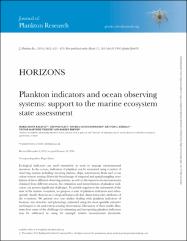Plankton indicators and ocean observing systems: support to the marine ecosystem state assessment

Göster/
Erişim
info:eu-repo/semantics/openAccessTarih
2014Yazar
Racault, Marie-FannyPlatt, Trevor
Sathyendranath, Shubha
Ağırbaş, Ertuğrul
Vicente, Victor Martinez
Brewin, Robert
Üst veri
Tüm öğe kaydını gösterKünye
Racault, M.F:, Platt, T., Sathyendranath, S., Agirbas, E., Vicente, V., Brewin, R., (2014).Plankton indicators and ocean observing systems: support to the marine ecosystem state assessment.Journal of Plankton Research, 36(3), 621-629.https://doi.org/10.1093/plankt/fbu016Özet
Ecological indicators are used extensively as tools to manage environmental resources. in the oceans, indicators of plankton can be measured using a variety of observing systems including: mooring stations, ships, autonomous floats and ocean colour remote sensing. Given the broad range of temporal and spatial sampling resolutions of these different observing systems, as well as discrepancies in measurements obtained from different sensors, the estimation and interpretation of plankton indicators can present significant challenges. To provide support to the assessment of the state of the marine ecosystem, we propose a suite of plankton indicators and subsequently classify them in an ecological framework that characterizes key attributes of the ecosystem. We present two case studies dealing with plankton indicators of biomass, size structure and phenology, estimated using the most spatially extensive and longest in situ and remote-sensing observations. Discussion of these studies illustrates how some of the challenges in estimating and interpreting plankton indicators may be addressed by using for example relative measurement thresholds, interpolation procedures and delineation of biogeochemical provinces. We demonstrate that one of the benefits attained, when analyzing a suite of plankton indicators classified in an ecological framework, is the elucidation of non-trivial changes in composition, structure and functioning of the marine ecosystem.

















